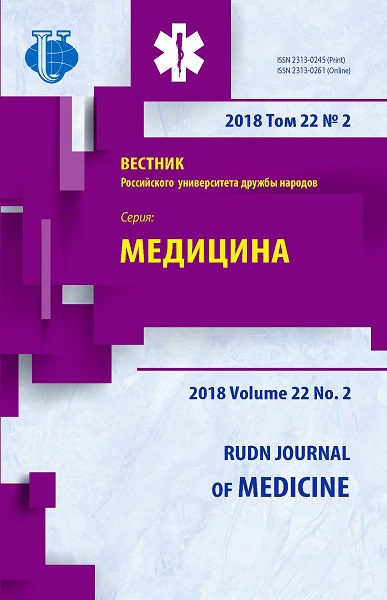МОНО- И МИКСТ-ГЕРПЕСВИРУСНЫЕ ИНФЕКЦИИ: АССОЦИИРОВАННОСТЬ С КЛИНИЧЕСКИМИ СИНДРОМАМИ ИММУНОДЕФИЦИТА
- Авторы: Нестерова ИВ1, Халтурина ЕО2
-
Учреждения:
- Кубанский государственный медицинский университет
- Первый Московский государственный медицинский университет имени И.М. Сеченова Министерства здравоохранения Российской Федерации
- Выпуск: Том 22, № 2 (2018)
- Страницы: 226-234
- Раздел: ИММУНОЛОГИЯ. ИНФЕКЦИОННАЯ ПАТОЛОГИЯ
- URL: https://journals.rudn.ru/medicine/article/view/18960
- DOI: https://doi.org/10.22363/2313-0245-2018-22-2-226-234
- ID: 18960
Цитировать
Полный текст
Аннотация
В настоящее время неуклонно растет распространенность герпесвирусных инфекций в человеческой популяции. Основной проблемой, возникающей при столкновении организма человека с различными представителями этого семейства, а особенно с ВЭБ, является наличие дефектов в системе интерферонов и нарушения в иммунной системе по типу иммунодефицита, которые могут носить как врожденный, генетически обусловленный, так и вторичный - приобретенный характер. При дефектах в системе ИФН и/или при иммунодефиците, как правило, инфекция имеет персистирующее течение, что приводит к развитию достаточно серьезных нозологических формы заболеваний, протекающих крайне тяжело, часто с развитием системных осложнений, приводящих к инвалидизации пациента. Проведены исследования особенностей функционирования системы противовирусной защиты, а также дефекты и нарушения в системе интерферонов у пациентов, страдающих различными моно-, микст-герпесвирусными инфекциями и бактериальными коинфекциями. Выявлены основные клинические синдромы, ассоциированные с этими герпетическими инфекциями, а также превалирующие нозологические формы сопутствующих заболеваний. Среди группы пациентов, страдающих моно-герпесвирусными инфекциями, лидирующее положение занимает аллергический синдром (55%), в то время как в структуре заболеваемости пациентов с микст-герпесвирусными инфекциями превалируют синдром хронической усталости (85%) и инфекционный синдром (68%). Расширенное тестирование состояния основных механизмов противовирусной защиты позволило выявить наиболее часто встречающиеся дефекты функционирования противовирусного иммунитета: нарушения индуцированной продукции ИФНα и ИФНγ, дефицит цитотоксических Т-лимфоцитов, дефицит естественных киллерных клеток, в т.ч. ЕКТ, и/или неадекватное отсутствие их активации, нейтропению. Выявленные клинические синдромы и особенности функционирования системы противовирусной защиты позволят в дальнейшем разработать концепцию комплексной, индивидуализированной, этио- и иммунопатогенетической терапии.
Ключевые слова
Об авторах
И В Нестерова
Кубанский государственный медицинский университет
Автор, ответственный за переписку.
Email: inesterova1@yandex.ru
доктор медицинских наук, профессор
Е О Халтурина
Первый Московский государственный медицинский университет имени И.М. Сеченова Министерства здравоохранения Российской Федерации
Email: inesterova1@yandex.ru
Список литературы
- Babcock J.G., Hochberg D., Thorley-Lawson A.D. The expression pattern of Epstein-Barr virus latent genes in vivo is dependent upon the differentiation stage of the infected B cell // Immunity. 2000. 13. P. 497-506.
- Hislop A.D., Taylor G.S., Sauce D., Rickinson A.B. Cellular responses to viral infection in humans: lessons from Epstein-Barr virus // Annu Rev Immunol. 2007. 25. P. 587-617.
- Kuzushima K., Matsuoka H. Impaired cytotoxic T lymphocyte response to Epstein-Barr virus-infected NK cells in patients with severe chronic active EBV infection // J Med Virol. 2001. 64:141-8.
- Lusso P. HHV-6 and the immune system: Mechanisms of immunomodulation and viral escape // J Clin Virol. 2006. 37(Suppl 1):S4-10.
- Merlo A., Turrini R., Dolcetti R., Martorelli D., Muraro E., Comoli P, Rosato A. The interplay between Epstein-Barr virus and the immune system: a rationale for adoptive cell therapy of EBV-related disorders // Haematologica. 2010. 95(10). P. 1769-1777.
- Ning S. Innate immune modulation in EBV infection // Herpesviridae. 2010. 2(1). P. 1.
- Pizzigallo Eligio, Racciatti Delia, and Gorgoretti Valeria. EBV Chronic Infections // Mediterr J Hematol Infect Dis. 2010. 2(1).
- Randall R.E., Goodbourn S. Interferons and viruses: an interplay between induction, signalling, antiviral responses and virus countermeasures // J. Gen. Virol. 2008. 89. P. 1-47.
- Wu L., Fossum E., Joo C.H., Inn K.S., Shin Y.C., Johannsen E., Hutt-Fletcher L.M., Hass J., Jung J.U. Epstein-Barr virus LF2: an antagonist to type I interferon // J Virol. 2009. 83(2). P. 1140-1146.
- Воробьев А.А., Киселевский М.В., Халтурина Е.О. Иммунная система // Иммунология. 2001. № 6. С. 15.
- Tracy S.I., Kalacheva K., Lunemann J.D., Luzuiaga K. et al. Persistence of Epstein-Barr virus in self-reactive memory B cells // J. Viorol. 2012. Vol. 88. № 22. P. 12330-12340.
- Olson D., Huntington M.K. Co-infections with cytomegalovirus and Epstein-Barr virus in mononucleosis: case report and review of literature // S D Med. 2009. V. 62. № 9. P. 351-353.
- Xia Wang et al. Coinfection with EBV/CMV and other respiratory agents in children with suspected infectious mononucleosis // Virol. J. 2010.V. 7. P. 247.
- Bravender T. Epstein-Barr virus, cytomegalovirus, and infectious mononucleosis // Adolesc. Med. State Art Rev. 2010. V. 21. № 2. P. 251-264.
- Юлиш Е.И. Персистирующие инфекции и человек: стратегия взаимоотношений // Здоровье ребенка. 2009. № 4. С. 114-122.
- van de Berg P.J.E.J., Griffiths S.J., Yong, S-L, Macaulay R., Jackson S., Henson S.M., ten Berge I.J.M., Akbar A.N., van Lier A.W. Cytomegalovirus Infection Reduces Telomere // J. Immunol. 2010. 184: 3417-3423.
- Poon S.S., Lansdorp P.M. // Current Protocols in Cell Biology. 2001. 12:18.4:18.4.1-18.4.21.
- Fukumoto H., Kanno T., Hasegawa H., Katano H. Pathology of Kaposi’s sarcoma-associated herpesvirus infection // Front Microbiol. 2010. 2: 175.
- Kutok J., Wang F. Spectrum of Epstein-Barr virus-associated diseases // Annu Rev Pathol. 2006. P. 375-404.
- Levin L., Munger K., O’Reilly E., Falk K., Ascherio A. Primary infection with Epstein-Barr virus and risk of multiple sclerosis // Ann Neurol. 2010. 67: 824-830.
Дополнительные файлы















